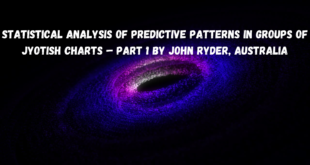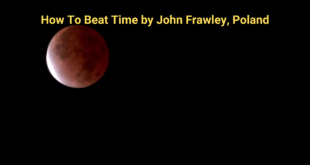Related Articles
In the science of predictive astrology, there are 3 famous system – Parasara, Jaimini and Yavana. Among them, Jamini school gives remarkable predictions using different methods from the other two:
In Yavana system, predictions are made in six ways :
- Grahaja : Results given by planets independently – Graha Karakatwas
- Bhavaja : Results given by bhavas independently – Bhava Karakatwas
- Rasija : Results given by Rasis independently – Based on quality and nature of
Rasis.
Graha Bhavaja : Results given by grahas because of their relationship with Bhavas
- Graha rasija : Results given by grahas because of their placement in rasis like Mesha etc.
- Graha Yogaja : Results given by grahas because of their relationship with rasis and bhavas
With the help of / using the included/ involved differences among these six results, distinct rasi sila, graham sila etc results, results of Dwigraha etc yogas are provided. Rewording the same as per my understanding: (Don’t know what is Rasi sila Graha sila) By using permutations and combinations of the above six results, predictions can be made on the effects of distinct Rasi sila, Graha sila etc (?)
Dwigrahadi yoga phala : Dwi = two
Graha = planet
Aadi = etc
Yoga = union
Phala = result
In their school / system, order of dasas is decide by the way of determining longevity (ayurdaya)
In parasara system, predictions are mainly based on bhavas (tanu etc 12 bhavas) and dasa antare. In this system, results related to the bhavas like tanu, dhanu, triteeya, chatur (fourth ) bhava etc are determined by the relationship between grahas and bhavas and their timing is determined from the results of dasa – antardasa. In Parasara system, there are graham dasas like vimsottari, astottari, shodasottari, dwadasottari etc based on the planets viz Sun etc. While determining the Dasa, dasanayana (?) difference is determined from the time of birth of the person. Most of the time, dasa – antardasa results are predicted using vimsottari dasa.
Jamini system while absorbing the topics from the above two systems, also mentions other topics and distinct / peculiar topics / subject matters. Absorbing the rasi dasas for making predictions, it gives out the way to determine the results of Dasas. Some things that cannot be known from the above two systems can be known in their system. Though Jaimini system s also commented about in a principal / primary / root book called parasara hora sastra by Maharshi parasara, due to non availability of complete and uncontaminated version of parasara hora sastra, it is getting difficult to clearly understand the topics in this system.
In the book Kalpalatavyakhya by Somanatha Mishra, it is mentioned that Maharshi Jaimini has written a book of 8 chapters in the form of sutras. It also mentions what are all topics included in the sutra sastra. The details are as follows :
Atha bhagvaanaacharyaha kala parignartham ganitashaastram sootradhyaya chatushtayam nirupya tadwaara sarveshaam jantunaamapi phalaparignaanarthamcha prabhu ranjanrdham cha ayurgnana para loka gnana ardhamcha karaka lagna drekkana nanamsadhibhihi upadesadhyaya chatushtayam prakatikaroti Maharshi Jaimini, the divine incarnation, has explained mathematics (Ganita Sastra) (theory related to calculation of planets, thithi etc) in four chapters and through these four chapters has enumerated ,means to predict good and bad results for all lives, determine the longevity , the knowledge about netherworlds, prediction regarding the lives of kings, using Karaka, lagna, drekkana and navamsa .
Asmin shaastre Prathama adhyaye sanghya karaka pada raja yoga adi nirnayate.
In this text – in the first chapter results on account of signs- padas- karakas-and rajayogas are indicated.
The are four sections in each chapter beginning the fist chapter to the fourth – thus totalling to sixteen sections (sutras).
- In the first chapter
- The first section contains 35 principles describing raasi drishtis , argala, the karakas for the soul , and arudha
- The second section describes in 121 principles the various results based on the karaka planet and its aspects.
- The third section contains 45 principles covering dhana yoga – raja yoga based on the arudha lagna
- The fourth section is divided into sub sections covering the spouse, progeny, siblings, and devotion to god in 49 principles
The first chapter contains 4 section sand 250 principles- Sutras
Dwitiya adhyayetu lagna , karaka for ayurdhaya dasan visheshadihi
In the second chapter various methods are described based on lagna,karaka planets determining the longevity, timing of death, and also methods to compute the dasas- periods are mentioned
In the second chapter Somantha describes 40 ways to compute the dasa but does not say anything about the order of the dasas. For determining this he asks us to refer to Kalidasas “Moola sastra “
Mukkula Raghava Bhatt mentions in his Ayurdaya Parichhedam the following dasa- periods while discussing longevity
- Hora dasa..2. Darpana Dasa. 3.Shoola Dasa. 4. Maheswara Dasa . 5. Athma Naadi dasa.6. Sthira Dasa. 7.Varna Dasa 8. Chara Paryaya Dasa 9.Athma bahvamsa Dasa Jaaya bhava Dasa 11 Athmabhavpamsa Dasa 12 Drekkana Dasa
Somanatha enumerates the following dasas in the second chapter
Atma Dasa 2. Chara Dasa 3 Varna Dasa . In this there are four types 4. Nakashatra Dasa 5. Navamsa Dasa 6. Sthira Dasa 7 Shoola Dasa 8 . Prakaranta Shoola Dasa 9. yoga Dasa or Yogartha dasa 10 Chara Dasa 11 Prakaraanta Dasa 12,13 Chara Dasa 14 Karaka Dasa 15 Sthira Paryaya Dasa and two more dasas 16 Nakshatra Das bedhamu 17 Trikona dasa 18 Dirshti Dasa 19 Kendra Dasaa
In the second Chapter methods to determine the longevity, death, longevity of father and mother are discussed in detail In the first section of the second chapter the persons’ longevity, timing of the dasa for the death and determining antardasa are laid down in 60 principles.
In the second section methods to decide the death of father, mother brother, causes for their death are mentioned in 33 sutras.
In the third section of the second chapter the different dasas their differences, their strengths, based on the differences the death of mother and the place are discussed in 30 sutras.
The fourth section contains the different chara dasas, dasaanayana , and determining the results are discussed in 37 sutras.
The first two chapters are very popular. For these the commentaries are available written by Nilakantha ,Krishnanada swamy , Achyutanada Jha ,Sitaram Jha and also references are available in Venakateswaara vritti, Guru vritti, Jaimini sutraartha prakasika and Jaiminipadyaamrutham.. In English articles published by Sri B.V. Raman are also available. In parasarahora Sastramu material is available in the form of Shlokas.
Regarding the third and fourth Chapters – we have with us commentaries in Sanskrit by Nilakantha . We understand that some translation was in published in Mumbai but we could not lay our hands. The copy with us is copied from manuscripts of my guru.
Mr. B,V. Raman had published commentary in English written by Sunil kumar Kaur of Kolkata
Somanatha has written commentary in the book named Kalpalatha in Sanskrit .However we could not get the full text. We could get the third Chapter completely and only the section 1 of the fourth chapter, The other sections are still not available.
Somanatha has described the following in the two chapters .
Thriteeya Adhyaye Drekkana Vishika Rajayoga, Ayurdaya , Antaranga Shidasayo dasanayanam , stree lakshanani cha .
In the third chapter in the first section the rajayogas related to Drekkana, the second section covers methods of computation of sixteen types of dasa according to the Antaranga Shastra, in the third section feminine qualities and in the fourth section degreecal aspects, the various types of dasas, determining yogas and their destruction and argalaa are covered.
In the Fourth Chapter death- its circumstances , foreign travel, matters relating to the other worlds, methods to compute 14 types of dasas are elaborated.
There are differences in the principles enumerated by Nilakanthacharya in the third and fourth chapters between the commentary and principles described in the book published by Sri S.K.Kaur
There are 145 principles (sutras) in fourth section of the third Chapter by Nilakantha which has no resemblance to the principles laid down by Sri S.K.Kaur. Hence we have to doubt the correctness of the fourth chapter by Nilakantha .
There is a similarity between those principles laid down by sri S..K. Kaur in the third and fourth chapters and book no D 13727 in the Madras oriental manuscripts library Chennai.
There are differences in the meaning to the principles written by Sri S.K.Kaur and Somantha .
In Somanthas Opinion:
The third chapter covers drekkana also known as antaranga sashtrs and has special importance.
In the third chapter Antharangashastra based on drekkana is described.
The shastra based on lagna, karaka, karakansha and arudha is known bahiranga sashtra . The antharanga shastra is more important than bahiranga shastra . Hence the third chapter gains vital importance.
Deciding The Dasas:
The second chapter For People born with rajayoga results must be based on the 11 dasas enumerated in the second chapter. In those only five apply to rulers-Kings. Out of the others dasa systems only four give rajayogas. They are yogartha, labhadhipathisthdrekkana, bhava rahasya, mandukaavati which raja yoga results. Any of these dasa give correct results.
Ordinary Dasas.
Nakshatra bheda , Nakshtraja Nisarga,chara,charaparyaya,sthiraparyaya,gocharadasa are for kings /rulers who do not have any yogas.
Dasas for determining the longevity
Brahma dasa, varna dasa, chara dasa, chara paryaya dasa are very useful in determing longevity.
Longevity must be determined basing the lagna, the lord of the eighth house , Chandra hora lagna, ghatika lagna and drekkana
Important In Determining The Bhava Phala
Lagna , Karaka, drekkana and anshakam are important. Amshakam is also known as Arudha padam.
The various lagna in determining the qualities of yoga are 1) Tripravana Lagna, 2) Sri lagna 3)Indu Lagna 4) Vilagna 5) Sri lagna 6) Bhagadhikansh Lagna . These are main lagnas and the less important are 1. Hora Lagna 2. Ghati Lagna and Chandra Lagna.
In determining the yogas, – the stress is on the planets. In the matter of Argala lagna drashta planet is important. Based on this Raja yogas can be decided.
He has thus described new methods. His father Krishna Misra in his Phala ratna Mala mentioning some more new methods states that he has based all these on the system followed by “Sarvagna Muni”. This is a very old system and teaches new techniques.
The modern methods are different from the traditional methods. As the traditional methods are destroyed it is very difficult to accurately say anything. In this are we have to get / trace old texts on ancient astrology. Even the Jains are working in the direction.
I hope this work will be partially or entirely complete by searching the old and ancient libraries in India.
Learn Astrology: Join Our Upcoming Astrology Classes — Click Here
Learn Astrology: Join Our Recorded Astrology Classes — Click Here
 Saptarishis Astrology Magazine Into Creating Astrologers
Saptarishis Astrology Magazine Into Creating Astrologers






